
Armament of the Iowa class battleship
Encyclopedia

In their World War II configuration, each of the Iowa-class battleships had a main battery
Artillery battery
In military organizations, an artillery battery is a unit of guns, mortars, rockets or missiles so grouped in order to facilitate better battlefield communication and command and control, as well as to provide dispersion for its constituent gunnery crews and their systems...
of 16 inches (406 mm) guns that could hit targets nearly 20 statute miles (32 km) away with a variety of artillery
Artillery
Originally applied to any group of infantry primarily armed with projectile weapons, artillery has over time become limited in meaning to refer only to those engines of war that operate by projection of munitions far beyond the range of effect of personal weapons...
shells designed for anti-ship or bombardment work. The secondary battery of 5 inches (127 mm) guns could hit targets nearly 9 statute miles (14 km) away with solid projectiles or proximity fuzed shells, and were equally adept in an anti-aircraft role and for damaging smaller ships. Each of the four battleships carried a wide array of 20 mm and 40 mm anti-aircraft guns
Anti-aircraft warfare
NATO defines air defence as "all measures designed to nullify or reduce the effectiveness of hostile air action." They include ground and air based weapon systems, associated sensor systems, command and control arrangements and passive measures. It may be to protect naval, ground and air forces...
for defense against enemy aircraft.
When reactivated and modernized in the 1980s each battleship retained the original battery of nine 16 inches (406 mm) guns, but the secondary battery on each battleship was reduced from ten twin-gun mounts and twenty guns to six twin-gun mounts with 12 guns to allow for the installation of two platforms for the Tomahawk missiles. Each battleship also received four Harpoon missile magazines, Phalanx
Phalanx CIWS
The Phalanx CIWS is an anti-ship missile defense system. It is a close-in weapon system and was designed and manufactured by the General Dynamics Corporation, Pomona Division...
anti-aircraft/anti-missile gatling gun
Gatling gun
The Gatling gun is one of the best known early rapid-fire weapons and a forerunner of the modern machine gun. It is well known for its use by the Union forces during the American Civil War in the 1860s, which was the first time it was employed in combat...
systems, and electronic warfare
Electronic warfare
Electronic warfare refers to any action involving the use of the electromagnetic spectrum or directed energy to control the spectrum, attack an enemy, or impede enemy assaults via the spectrum. The purpose of electronic warfare is to deny the opponent the advantage of, and ensure friendly...
suites.
Turrets
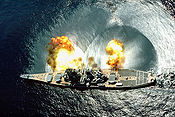
Breech-loading weapon
A breech-loading weapon is a firearm in which the cartridge or shell is inserted or loaded into a chamber integral to the rear portion of a barrel....
16 inch (406 mm)/50-caliber Mark 7 naval guns
16 inch (406 mm)/50 caliber Mark 7 naval gun
The 16"/50 caliber Mark 7 - United States Naval Gun is the main armament of the Iowa-class battleships.Due to a lack of communication during design, the Bureau of Ordnance assumed the Iowa class would use the 16"/50 Mark 2 guns constructed for the 1920 South Dakota-class battleships...
, which were housed in three 3-gun turret
Gun turret
A gun turret is a weapon mount that protects the crew or mechanism of a projectile-firing weapon and at the same time lets the weapon be aimed and fired in many directions.The turret is also a rotating weapon platform...
s: two forward and one aft in a configuration known as "2-A-1". The guns were 66 feet (20 m) long (50 times their 16 inches (406.4 mm) bore, or 50 calibers, from breechface
Breechface
In firearms the breech face, also breechface, is the surface of the bolt or slide that locks against the rear of the chamber so that one can fire a cartridge....
to muzzle
Muzzle (firearm)
The muzzle of a firearm is the end of the barrel from which the projectile will exit.Precise machining of the muzzle is crucial to accuracy, because it is the last point of contact between the barrel and the projectile...
). About 43 feet (13 m) protruded from the gun house. Each gun weighed about 239,000 pounds (108 000 kg) without the breech, or 267,900 pounds with the breech. They fired projectiles weighing from 1900 to 2700 lb (861.8 to 1,224.7 ) at a muzzle velocity
Muzzle velocity
Muzzle velocity is the speed a projectile has at the moment it leaves the muzzle of the gun. Muzzle velocities range from approximately to in black powder muskets , to more than in modern rifles with high-performance cartridges such as the .220 Swift and .204 Ruger, all the way to for tank guns...
of 2,690 ft/s (820 m/s) to a maximum range of 42345 yards (38,720.3 m) (42345 yards (24.06 mi)) using an armor-piercing
Armor-piercing shot and shell
An armor-piercing shell is a type of ammunition designed to penetrate armor. From the 1860s to 1950s, a major application of armor-piercing projectiles was to defeat the thick armor carried on many warships. From the 1920s onwards, armor-piercing weapons were required for anti-tank missions...
shell.
Each gun rested within an armored turret, but only the top of the turret protruded above the main deck. The turret extended either four decks (Turrets 1 and 3) or five decks (Turret 2) down. The lower spaces contained the equipment required to rotate the turret and to elevate the guns attached to each turret. At the bottom of the turret were rooms which were used for handling the projectiles and storing the powder bags used to fire them. All of the compartments within the turrets were separated by flameproof bulkheads to prevent any flame or lethal gas from spreading throughout the turret. Each turret required a crew of 77—94 men to operate. The turrets were not actually attached to the ship, but sat on rollers, which meant that if the ship were to capsize
Capsize
Capsizing is an act of tipping over a boat or ship to disable it. The act of reversing a capsized vessel is called righting.If a capsized vessel has sufficient flotation to prevent sinking, it may recover on its own if the stability is such that it is not stable inverted...
the turrets would fall out. Each turret cost US $1.4 million, but this number did not include the cost of the guns themselves.
The turrets were "three-gun," not "triple," because each barrel could be elevated and fired independently. The ship could fire any combination of its guns, including a broadside
Broadside
A broadside is the side of a ship; the battery of cannon on one side of a warship; or their simultaneous fire in naval warfare.-Age of Sail:...
of all nine. Contrary to myth, the ships do not move noticeably sideways when a broadside was fired.
The guns could be elevated from −5° to +45°, moving at up to 12° per second. The turrets could be rotated about 300° at a rate of about four degrees per second and can even be fired back beyond the beam
Beam (nautical)
The beam of a ship is its width at the widest point. Generally speaking, the wider the beam of a ship , the more initial stability it has, at expense of reserve stability in the event of a capsize, where more energy is required to right the vessel from its inverted position...
, which is sometimes called "over the shoulder." The guns were never fired horizontally forward (in the 1980s refit, a satellite up-link antenna was mounted at the bow). To distinguish between the rounds fired from different battleships the Iowa class used dye bags which allowed artillery observers to determine which rounds had been fired by which ship. Iowa, New Jersey, Missouri, and Wisconsin were assigned the colors Orange, Blue, Red and Green, respectively.
Within each turret a red stripe on the wall of the turret, inches from the railing, marked the boundary of the gun's recoil, warning the crew to keep back.
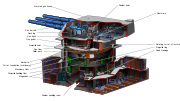
After the guns were fired, each rifle barrel had to be cleaned. Unlike small caliber guns which can be field-stripped, the guns aboard an Iowa-class battleship could not be disassembled, so the gunners mates assigned the job of cleaning the rifles required a full day or more to ensure that the barrels were correctly and adequately cleaned. To clean the rifles, a bore brush was lifted by two sailors and inserted into the gun barrel, where it was pulled through the rifle with the same equipment used to load the shells. Within the turret, crewmen checked to ensure that the breech fittings were properly cleaned and lubricated, while sailors outside the turret scraped off soot, and painted over flash burns left from the explosive expulsion of the 16-inch shells from the gun barrels.

Fire Control
The early main battery fire control consisted of the Fire Control Tower, two Mark 38 Gun Fire Control Systems (GFCS), and fire control equipment located in two of the three turrets. As modernized in the 1980s, each turret carried a DR-810 radar that measured the muzzle velocity of each gun, which made it easier to predict the velocity of succeeding shots. Together with the Mark 160 FCS and better propellant consistency, these improvements made these weapons into the most accurate battleship-caliber guns ever made.Fire Control Tower
The Fire Control Tower (pictured) was the Gunnery Officer's heavily armored battle station, and it was accessible to the Captain's heavily armored battle station, the Battle Bridge. It was equipped with periscopes poking through the armor, and control consoles showing the status of the ship's weapons (director bearings, turret bearings, gun's loaded status, Fire Control (FC) Radar displays, ...). With the radar's displays, the Gunnery Officer could determine what Spots (aim corrections) were needed by watching the fall of shot around the target.Mark 38 Gun Fire Control System
The major components of the Mk38 Gun Fire Control System (GFCS) were the Director, Plotting Room, and interconnecting data transmission equipment. Two systems, forward and aft, were each complete and independent. Their plotting rooms were isolated to protect against battle damage propagating from one to the other.Director

Radar
Radar is an object-detection system which uses radio waves to determine the range, altitude, direction, or speed of objects. It can be used to detect aircraft, ships, spacecraft, guided missiles, motor vehicles, weather formations, and terrain. The radar dish or antenna transmits pulses of radio...
. (The FC radar was the preferred method.) The present position of the target was called the Line-Of-Sight (LOS), and it was continuously sent down to the Mk 8 Rangekeeper in the plotting room by Synchro
Synchro
A synchro is a type of rotary electrical transformer that is used for measuring the angle of a rotating machine such as an antenna platform. In its general physical construction, it is much like an electric motor...
transmitters. Also, when not using the radar's display to determine Spots, the director was the optical spotting station.
Plotting Room
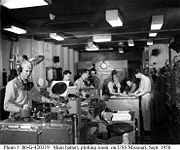
Parallax
Parallax is a displacement or difference in the apparent position of an object viewed along two different lines of sight, and is measured by the angle or semi-angle of inclination between those two lines. The term is derived from the Greek παράλλαξις , meaning "alteration"...
Correctors, Fire Control Switchboard, battle telephone switchboard, battery status indicators, assistant Gunnery Officers, and Fire Control Technicians (FTs).
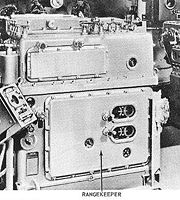
Analog computer
An analog computer is a form of computer that uses the continuously-changeable aspects of physical phenomena such as electrical, mechanical, or hydraulic quantities to model the problem being solved...
whose function was to continuously calculate the gun's bearing and elevation, Line-Of-Fire (LOF), to hit a future position of the target. It did this by automatically receiving information from the director (LOS), the FC Radar (range), the ship's gyrocompass
Gyrocompass
A gyrocompass is a type of non-magnetic compass which bases on a fast-spinning disc and rotation of our planet to automatically find geographical direction...
(true ship's course), the ship's Pitometer log
Pitometer log
Pitometer logs are devices used to measure a ship's speed relative to the water. They are used on both surface ships and submarines...
(ship's speed), the Stable Vertical (ship's roll and pitch), and the ship's anemometer (relative wind speed and direction). Also, before the surface action started, the FTs made manual inputs for the average initial velocity of the projectiles fired out of the battery's gun barrels, and air density. With all this information, the Rangekeeper calculated the relative motion between the ship and the target. It then could calculate an offset angle and change of range between the target's present position (LOS) and future position at the end of the projectile's time of flight. To this bearing and range offset, it added corrections for gravity, wind, Magnus Effect
Magnus effect
The Magnus effect is the phenomenon whereby a spinning object flying in a fluid creates a whirlpool of fluid around itself, and experiences a force perpendicular to the line of motion...
of the spinning projectile, earth's curvature, and coriolis effect
Coriolis effect
In physics, the Coriolis effect is a deflection of moving objects when they are viewed in a rotating reference frame. In a reference frame with clockwise rotation, the deflection is to the left of the motion of the object; in one with counter-clockwise rotation, the deflection is to the right...
. The result was the turret's bearing and elevation orders (LOF). During the surface action, range and deflection Spots and target altitude (not zero during Gun Fire Support) were manually entered.

Salvo
A salvo is the simultaneous discharge of artillery or firearms including the firing of guns either to hit a target or to perform a salute.Troops armed with muzzleloaders required time in which to refill their arms with gun powder and shot...
Signal Key, and it sounded the Salvo Buzzer in each of the turrets to warn the gun crews that the guns were about to fire. The center key (with bumps on its handle for tactile identification) was the Automatic Firing Key. When this key was held closed, the Mk 41 was enabled to automatically fire the guns whenever the ship's deck was parallel the horizontal plane. Also, if the sea state was such that the turrets' elevation power drives could not keep up with the ship's motion, the guns could be held at a fixed elevation, and the MK 41 could again automatically fire the guns as described. The right key was the Hand Firing Key. It bypassed the Mk 41, and fired the guns directly.
The Mk 13 FC Radar supplied present target range, and it showed the fall of shot around the target so the Gunnery Officer could correct the system's aim with range and deflection spots put into the Rangekeeper. It could also automatically track the target by controlling the director's bearing power drive. Because of radar, Fire Control systems are able to track and fire at targets at a greater range and with increased accuracy during the day, night, or inclement weather. This was demonstrated in November 1942 when the battleship engaged the Imperial Japanese Navy
Imperial Japanese Navy
The Imperial Japanese Navy was the navy of the Empire of Japan from 1869 until 1947, when it was dissolved following Japan's constitutional renunciation of the use of force as a means of settling international disputes...
battlecruiser
Battlecruiser
Battlecruisers were large capital ships built in the first half of the 20th century. They were developed in the first decade of the century as the successor to the armoured cruiser, but their evolution was more closely linked to that of the dreadnought battleship...
Kirishima
Japanese battleship Kirishima
was a warship of the Imperial Japanese Navy during World War I and World War II. Designed by British naval engineer George Thurston, she was the third launched of the four Kongō-class battlecruisers, among the most heavily armed ships in any navy when built...
at a range of 18500 yards (16,916.4 m) at night. The engagement left Kirishima in flames, and she was ultimately scuttled by her crew. This capability gave the United States Navy a major advantage in World War II, as the Japanese did not develop radar or automated fire control to the level of the US Navy and were at a significant disadvantage. See also The Battle of Surigao Strait (25 October 1944) during the WWII Leyte Gulf landings.
The Parallax
Parallax
Parallax is a displacement or difference in the apparent position of an object viewed along two different lines of sight, and is measured by the angle or semi-angle of inclination between those two lines. The term is derived from the Greek παράλλαξις , meaning "alteration"...
Correctors were needed because the turrets were located hundreds of feet from the director. There was one for each turret, and each had the turret/director distance manually set in. They automatically received Relative Target Bearing (bearing from own ship's bow), and Target Range. They corrected the bearing order for each turret so that all rounds fired in a salvo converged on the same point.
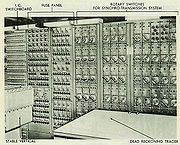
The assistant Gunnery Officers and Fire Control Technicians operated the equipment, talked to the turrets and ship's command by sound-powered telephone
Sound-powered telephone
A sound-powered telephone is a communication device that allows users to talk to each other with the use of a handset, similar to a conventional telephone, but without the use of external power...
, and watched the Rangekeeper's dials and system status indicators for problems. If a problem arose, they could correct the problem, or reconfigure the system to mitigate its effect.
Turret Fire Control Systems
Turrets 2 & 3 had optical rangefinders (the side boxes on the turret's right and left rear corners). If in a surface action, the GFCSs were damaged, or the cable carrying the bearing and elevation order signals to the turret was cut, the Turret Officer could turn a rotary switch to put his turret in local control. Then, he could continue the action using the fire control equipment in the turret.Ammunition
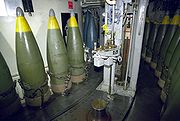
The Mk. 8 APC (Armor-Piercing, Capped) shell weighed 2,700 lb (1225 kg) and was designed to penetrate the hardened steel armor carried by foreign battleships. At 20,000 yards (18 km) the Mk. 8 could penetrate 20 inches (500 mm) of steel armor plate. At the same range, the Mk. 8 could penetrate 21 feet (6.4 m) of reinforced concrete.
For unarmored targets and shore bombardment, the 1,900 lb (862 kg) Mk. 13 HC (High-Capacity—referring to the large bursting charge) shell was available. The Mk. 13 shell would create a crater
Impact crater
In the broadest sense, the term impact crater can be applied to any depression, natural or manmade, resulting from the high velocity impact of a projectile with a larger body...
50 feet (15 m) wide and 20 feet (6 m) deep upon impact and detonation, and could defoliate trees 400 yards (360 m) from the point of impact.
The final type of ammunition developed for the Iowa class were "Katie" shells. These shells were born from the concept of nuclear deterrence
Mutual assured destruction
Mutual Assured Destruction, or mutually assured destruction , is a doctrine of military strategy and national security policy in which a full-scale use of high-yield weapons of mass destruction by two opposing sides would effectively result in the complete, utter and irrevocable annihilation of...
that had begun to shape the United States armed forces as the Cold War began. To compete with the Air Force
United States Air Force
The United States Air Force is the aerial warfare service branch of the United States Armed Forces and one of the American uniformed services. Initially part of the United States Army, the USAF was formed as a separate branch of the military on September 18, 1947 under the National Security Act of...
and the Army
United States Army
The United States Army is the main branch of the United States Armed Forces responsible for land-based military operations. It is the largest and oldest established branch of the U.S. military, and is one of seven U.S. uniformed services...
, which had developed nuclear bombs and nuclear shells for use on the battlefield, the US Navy began a top-secret program to develop Mk. 23 nuclear naval shells with an estimated yield of 15 to 20 kilotons. These shells were designed to be launched from the best seaborne artillery platform available, which at the time were the four ships of the Iowa class. The shells entered development around 1953, and were reportedly ready by 1956; however, it is not known whether they were ever actually deployed on the Iowa-class battleships because the US Navy does not confirm or deny the presence of nuclear weapons aboard its ships. In 1991 the US unilaterally withdrew its nuclear artillery shells from service, and Russia responded in kind in 1992. The US removed around 1,300 nuclear shells from Europe and reportedly dismantled its last shells by 2003.
Secondary battery
The secondary battery was a dual-purpose weapon system; it was designed to defend the ship from either surface or airborne threats. The original secondary battery consisted of 10 Mark 28, Mod 2 twin gun mounts, and four Mark 37 Gun Fire Control Systems. At first, this battery's effectiveness against aircraft diminished as planes became faster, but this changed toward the end of World War IIWorld War II
World War II, or the Second World War , was a global conflict lasting from 1939 to 1945, involving most of the world's nations—including all of the great powers—eventually forming two opposing military alliances: the Allies and the Axis...
through a combination of an upgrade to the Mk37 System and the development of the VT (Variable Time) proximity fuze
Proximity fuze
A proximity fuze is a fuze that is designed to detonate an explosive device automatically when the distance to target becomes smaller than a predetermined value or when the target passes through a given plane...
. In preparation for the reactivations in the 1960s and 1980s, the battery was updated to the latest gun and fire control system modifications. In the 1968 upgrade to the USS New Jersey for service off Vietnam, three Mark 56 Gun Fire Control Systems were installed, two on either side just forward of the aft stack, and one between the aft mast and the aft Mk 38 Director tower. This increased New Jersey's anti-aircraft capability, because the Mk 56 system could track and shoot at faster planes. In the 1980s modernization, the Mk 56 GFCSs and four mounts were removed to make room for missiles, leaving the Secondary battery with four Mk 37 GFCSs and six twin mounts on all the Iowa class. By the time of the Gulf War
Gulf War
The Persian Gulf War , commonly referred to as simply the Gulf War, was a war waged by a U.N.-authorized coalition force from 34 nations led by the United States, against Iraq in response to Iraq's invasion and annexation of Kuwait.The war is also known under other names, such as the First Gulf...
the secondary battery was largely relegated to shore bombardment and littoral
Littoral
The littoral zone is that part of a sea, lake or river that is close to the shore. In coastal environments the littoral zone extends from the high water mark, which is rarely inundated, to shoreline areas that are permanently submerged. It always includes this intertidal zone and is often used to...
defense. Since each battleship carried a small detachment of Marines
United States Marine Corps
The United States Marine Corps is a branch of the United States Armed Forces responsible for providing power projection from the sea, using the mobility of the United States Navy to deliver combined-arms task forces rapidly. It is one of seven uniformed services of the United States...
aboard, the Marines would man one of the 5-inch gun mounts.
Mark 28, Mod 2 Mounts
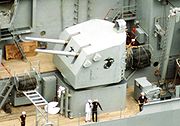
Mark 12 Gun Assembly

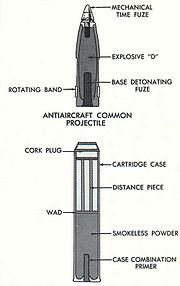
Electric-Hydraulic Drives
The electric-hydraulic drives powered the mount's motion. The three modes of drive operation were automatic, local, and manual. In automatic, the drives would follow the bearing and elevation orders of the fire control system. In local, the drives would follow the motion of the trainer's and pointer's hand wheels. (This is similar to power steering on a car.) Manual was direct gear linkage from the hand wheels to move the mount with no power assist.Sights
The periscopic sights (the boxes on the side of the mount) allowed the trainer and pointer to see the target from inside the armored enclosure. Each sight had movable prisms that allowed its line of sight to be moved relative to the barrel's bore axis. These prisms could be controlled by the fire control system when the mount was in Automatic, or by the mount’s sight setter operator when the mount was in Local. Local control was not the preferred combat method, but it could be used if the fire control systems were damaged. The mount captain was trained in aiming and correcting the fall of shot.Upper Handling room
The upper handling room was just below the visible part of the mount. It was armored and reinforced to support the weight of the mount. A person standing in the upper handling room could look up and see the bottom of the gun mount inside the training circle on which the mount rotated. Hanging from the mount, and rotating with it, was the equipment used to pass ammunition up to the mount. This included the lower ends of the projectile and powder case hoists. In the center of the room there was a vertical tube that also turned with the mount. This tube enclosed the electrical power and control cables going up to the mount. Around the perimeter of the upper handling room were the ready service ammunition racks welded to the bulkheads. Close by, either in a corner of the handling room or in an adjoining compartment was the upper end of an ammunition hoist from the magazine. The responsibility of the men stationed in the upper handling room was to shuttle 30 to 40 projectiles and 30 to 40 powder cases per minute from the ready service racks to the hoists while avoiding the equipment rotating with the mount. During quiet spells, they would replenish the ready service racks with ammunition from the magazines.Mark 37 Gun Fire Control System
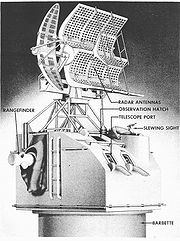
Mark 37 Director
The function of the Mark 37 Director (pictured) was to track the present position of the target in bearing, elevation, and range. To do this, it had optical sights (the rectangular widows on the front), an optical rangefinder (the tubes sticking out each side), and Fire Control Radar antennas. On the MK 37 Director pictured, the rectangular antenna is for the Mark 12 FC radar, and the parabolic antenna on the left is for the Mk 22 FC radar. They were part of an upgrade to improve tracking of aircraft. The Director Officer also had a Slew Sight that he could use to quickly point the director towards a new target.Plotting Room
The Secondary Battery Plotting Rooms were down below the waterline and inside the armor belt. They contained four complete sets of fire control equipment needed to aim and shoot at four targets. Each set included a Mark 1A computer, a Mark 6 Stable Element, FC Radar controls and displays, Parallax correctors, a switchboard, and crew to operate it all.The Mark 1A Fire Control Computer
Mark I Fire Control Computer
The Mark 1, and later the Mark 1A, Fire Control Computer was a component of the Mark 37 Gun Fire Control System deployed by the United States Navy during World War II and up to 1969. It was used on a variety of ships, ranging from destroyers to battleships . The Mark 37 system used tachymetric...
(pictured) was an electro-mechanical analog ballistic computer. Its function was to automatically aim the guns so that a fired projectile would collide with the target. This was the same function as the main battery’s Mk 8 Rangekeeper above except that some of the targets the Mark 1A had to deal with also moved in elevation — and much faster. For a surface target, the Secondary Battery’s Fire Control problem is the same as the Main Battery’s with the same type inputs and outputs. The major difference between the two computers was their ballistics calculations. The amount of gun elevation needed to project a 5-inch (127 mm) shell 9 nmi (16.7 km) is different than the elevation needed to project a 16-inch shell the same distance. The ballistics calculations in these mechanical analog computers were performed by mechanisms like differential gears, levers, and small rods riding on the surface of three-dimensional cams. These mechanical adders, multipliers, and table lookup devices were hand made at the factory, and were buried deep in the workings of the computer. It was not possible to change a computer’s ballistics at sea until the advent of fast digital computers. The anti-aircraft fire control problem was more complicated because it had the additional requirement of tracking the target in elevation and making target predictions in three dimensions. The outputs of the Mk 1A were the same (gun bearing and elevation), except fuze time was added. The fuze time was needed because the ideal of directly hitting the fast moving aircraft with the projectile was impractical. With fuze time set into the shell, it was hoped that it would explode near enough to the target to destroy it with the shock wave and shrapnel. Towards the end of World War II
World War II
World War II, or the Second World War , was a global conflict lasting from 1939 to 1945, involving most of the world's nations—including all of the great powers—eventually forming two opposing military alliances: the Allies and the Axis...
, the invention of the VT proximity fuze
Proximity fuze
A proximity fuze is a fuze that is designed to detonate an explosive device automatically when the distance to target becomes smaller than a predetermined value or when the target passes through a given plane...
eliminated the need to use the fuze time calculation and its possible error. This greatly increased the odds of destroying an air target.
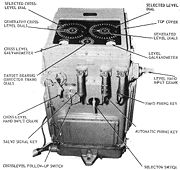
The Fire-control radar
Fire-control radar
A fire-control radar is a radar which is designed specifically to provide information to a fire-control system in order to calculate a firing solution...
used on the Mk 37 GFCS has evolved. In the 1930s, the Mk 37 Director did not have a radar antenna. Then in September 1941, the rectangular Mk 4 Fire-control radar antenna was mounted on top. Soon aircraft flew faster, and in c1944 to increase speed and accuracy the Mk 4 was replaced by a combination of the Mk 12 (rectangular antenna) and Mk 22 (parabolic antenna) radars. (pictured) Finally, the circular SPG 25 antenna was mounted on top as seen in the USS Wisconsin photo at the top of this article. (Look at the Mk 37 Director just above the bridge.)
Anti-aircraft batteries
_oerlikon_20mm_aa_gun_mount.jpg)
Oerlikon 20 mm anti-aircraft guns
The OerlikonOerlikon Contraves
Rheinmetall Air Defence AG is a division of German armament manufacturer Rheinmetall, created when the company's Oerlikon Contraves unit was renamed on 1 January 2009 and integrated with Rheinmetall's other air-defence products...
20 mm anti-aircraft gun
Oerlikon 20 mm cannon
The Oerlikon 20 mm cannon is a series of autocannons, based on an original design by Reinhold Becker of Germany, very early in World War I, and widely produced by Oerlikon Contraves and others...
was one of the most heavily produced anti-aircraft guns of the Second World War; the US alone manufactured a total of 124,735 of these guns. When activated in 1941 these guns replaced the 0.50"/90 (12.7 mm) M2 Browning MG on a one-for-one basis. The Oerlikon 20 mm AA gun remained the primary anti-aircraft weapon of the United States Navy until the introduction of the 40 mm Bofors AA gun
Bofors 40 mm gun
The Bofors 40 mm gun is an anti-aircraft autocannon designed by the Swedish defence firm of Bofors Defence...
in 1943.
These guns were air-cooled and used a gas blowback recoil system. Unlike other automatic guns employed during World War II the barrel of the 20 mm Oerlikon gun did not recoil, the breechblock never locked against the breech and actually moved forward when the gun fired. This weapon lacked a counter-recoil brake, as the force of the counter-recoil was checked by the explosion of the next round of ammunition.
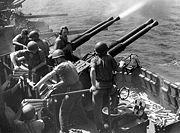
Kamikaze
The were suicide attacks by military aviators from the Empire of Japan against Allied naval vessels in the closing stages of the Pacific campaign of World War II, designed to destroy as many warships as possible....
attacks used during the latter half of World War II. They were subsequently phased out in favor of the heavier 40 mm Bofors AA gun
Bofors 40 mm gun
The Bofors 40 mm gun is an anti-aircraft autocannon designed by the Swedish defence firm of Bofors Defence...
s.
Bofors 40 mm anti-aircraft guns

United States customary units
United States customary units are a system of measurements commonly used in the United States. Many U.S. units are virtually identical to their imperial counterparts, but the U.S. customary system developed from English units used in the British Empire before the system of imperial units was...
) with interchangeable ammunition, which simplified the logistics situation for World War II. When coupled with electric-hydraulic drives for greater speed and the Mark 51 Director (pictured) for improved accuracy, the Bofors 40 mm gun became a fearsome adversary, accounting for roughly half of all Japanese aircraft shot down between 1 October 1944 and 1 February 1945.
When the Iowa-class battleships were launched in 1943 and 1944 they carried twenty quad Bofors 40 mm gun mounts, which they used for defense against enemy aircraft. These heavy guns were also employed in the protection of allied aircraft carriers operating in the Pacific Theater of World War II
Pacific Theater of Operations
The Pacific Theater of Operations was the World War II area of military activity in the Pacific Ocean and the countries bordering it, a geographic scope that reflected the operational and administrative command structures of the American forces during that period...
. These guns remained on the battleships Iowa, Missouri, and Wisconsin from the time they were commissioned until they were reactivated for service in the 1980s. As each battleship arrived for modernization during the early and mid 1980s the Bofors mounts that remained aboard were removed due in large part to the ineffectiveness of such manually aimed weapons against modern day jet fighters and enemy missiles. The replacement for the Bofors guns was the US Navy's Phalanx
Phalanx CIWS
The Phalanx CIWS is an anti-ship missile defense system. It is a close-in weapon system and was designed and manufactured by the General Dynamics Corporation, Pomona Division...
Close-in weapon system
Close-in weapon system
A close-in weapon system , often pronounced sea-whiz, is a naval shipboard point-defense weapon for detecting and destroying at short range incoming anti-ship missiles and enemy aircraft which have penetrated the outer defenses....
(CIWS).
Phalanx CIWS
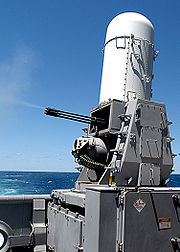
Phalanx CIWS
The Phalanx CIWS is an anti-ship missile defense system. It is a close-in weapon system and was designed and manufactured by the General Dynamics Corporation, Pomona Division...
mounts, two of which sat just behind the bridge and two which were next to the after ship's funnel. , , and were equipped with the Block 0 version of the Phalanx, while received the first operational Block 1 version in 1988.
Developed as the final line of defense (terminal defense or point defense) against anti-ship missiles, the Phalanx Close in Weapon System (CIWS, pronounced "sea-whiz") is the anti-aircraft/anti-missile gun currently in use in the US Navy. Due to their distinctive shape, they have been nicknamed "R2D2s", in reference to the droid R2-D2
R2-D2
R2-D2 , is a character in the Star Wars universe. An astromech droid, R2-D2 is a major character throughout all six Star Wars films. Along with his droid companion C-3PO, he joins or supports Anakin Skywalker, Luke Skywalker, Princess Leia, and Obi-Wan Kenobi in various points in the saga...
from the Star Wars
Star Wars
Star Wars is an American epic space opera film series created by George Lucas. The first film in the series was originally released on May 25, 1977, under the title Star Wars, by 20th Century Fox, and became a worldwide pop culture phenomenon, followed by two sequels, released at three-year...
universe. Designed in the early 1970s by General Dynamics
General Dynamics
General Dynamics Corporation is a U.S. defense conglomerate formed by mergers and divestitures, and as of 2008 it is the fifth largest defense contractor in the world. Its headquarters are in West Falls Church , unincorporated Fairfax County, Virginia, in the Falls Church area.The company has...
, and currently produced by Raytheon
Raytheon
Raytheon Company is a major American defense contractor and industrial corporation with core manufacturing concentrations in weapons and military and commercial electronics. It was previously involved in corporate and special-mission aircraft until early 2007...
, the Phalanx CIWS mount utilizes a 20 mm M61 Vulcan
M61 Vulcan
The M61 Vulcan is a hydraulically or pneumatically driven, six-barreled, air-cooled, electrically fired Gatling-style rotary cannon which fires 20 mm rounds at an extremely high rate. The M61 and its derivatives have been the principal cannon armament of United States military fixed-wing aircraft...
gatling gun
Gatling gun
The Gatling gun is one of the best known early rapid-fire weapons and a forerunner of the modern machine gun. It is well known for its use by the Union forces during the American Civil War in the 1860s, which was the first time it was employed in combat...
to destroy enemy missiles and aircraft that manage to escape anti-missile and anti-aircraft missiles fired from friendly ships.
The Phalanx guns worked by using a search radar and a tracking radar to follow targets that approached within 1 to 1.5 nautical miles (2.8 km). When a target was within this range the CIWS mount moved to track the target while simultaneously evaluating the target against several preset criteria to determine the next course of action. Depending on whether the target criteria were met, the Phalanx mount automatically engaged the incoming target if it was judged to be hostile in nature, or the system recommended that the Phalanx operator engage the target.
Phalanx CIWS mounts were used by Missouri and Wisconsin during the 1991 Gulf War
Gulf War
The Persian Gulf War , commonly referred to as simply the Gulf War, was a war waged by a U.N.-authorized coalition force from 34 nations led by the United States, against Iraq in response to Iraq's invasion and annexation of Kuwait.The war is also known under other names, such as the First Gulf...
; Wisconsin alone fired 5,200 20 mm Phalanx CIWS rounds. Missouri also received Phalanx fire during a "friendly fire
Friendly fire
Friendly fire is inadvertent firing towards one's own or otherwise friendly forces while attempting to engage enemy forces, particularly where this results in injury or death. A death resulting from a negligent discharge is not considered friendly fire...
" incident in which the Perry-class
Oliver Hazard Perry class frigate
The Oliver Hazard Perry class is a class of frigates named after the American Commodore Oliver Hazard Perry, the hero of the naval Battle of Lake Erie...
guided missile frigate mistook chaff
Chaff (radar countermeasure)
Chaff, originally called Window by the British, and Düppel by the Second World War era German Luftwaffe , is a radar countermeasure in which aircraft or other targets spread a cloud of small, thin pieces of aluminium, metallized glass fibre or plastic, which either appears as a cluster of secondary...
fired by Missouri for a legitimate target and shot at Missouri. Rounds from this attack struck the ship in the bulkhead above the famed "surrender deck" and bounced off the armor, one round penetrated the forward funnel and passed completely through it, and another round penetrated a bulkhead and embedded in an interior passageway of the ship.
Missiles
During the modernization in the 1980s, three important weapons were added to the Iowa-class battleships. The first was the CIWS anti-aircraft/anti-missile system discussed above. The other two were missiles for use against both land and sea targets. At one point the NATO Sea Sparrow was to be installed on the reactivated battleships; however, it was determined that the system could not withstand the over-pressure effects when the main battery was fired.Tomahawk land attack missile
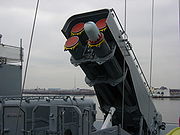
BGM-109 Tomahawk
The Tomahawk is a long-range, all-weather, subsonic cruise missile. Introduced by General Dynamics in the 1970s, it was designed as a medium- to long-range, low-altitude missile that could be launched from a surface platform. It has been improved several times and, by way of corporate divestitures...
(TLAM) was first introduced in the 1970s, and entered service with the United States in 1983. Designed as a long-range, all-weather, subsonic cruise missile
Cruise missile
A cruise missile is a guided missile that carries an explosive payload and is propelled, usually by a jet engine, towards a land-based or sea-based target. Cruise missiles are designed to deliver a large warhead over long distances with high accuracy...
, the Tomahawk was capable of reaching targets at a much greater range than the 16 inches (406 mm) guns on the Iowa-class ships. When added to the battleships in the 1980s the Tomahawk became the longest-ranged weapon carried by the battleships.
Owing to the original 1938 design of the battleships, the Tomahawk missiles could not be fitted to the Iowa-class unless the battleships were physically rebuilt in such a way as to accommodate the missile mounts that would be needed to store and launch the Tomahawks. This realization prompted the removal of the anti-aircraft guns previously installed on the Iowas and the removal of four of each of the battleships' ten 5"/38 DP mounts. The mid and aft end of the battleships were then rebuilt to accommodate the missile magazines. This resulted in the construction of two separate platforms, one located between the first and second funnel and one located behind the second funnel, to which MK-143 Armored Box Launcher
Armored Box Launcher
The Armored Box Launcher is a four-round protected launch container for the BGM-109 Tomahawk Cruise Missile.Fitted to the Iowa-class battleships following their 1980s recommissioning upgrade, each ABL contains four ready-to-fire Tomahawks...
(ABL) canisters could be attached. Each Armored Box Launcher carried four missiles, and each of the battleships was outfitted with eight canisters, enabling the Iowa-class to carry and fire a total of 32 Tomahawk missiles.
The type of Tomahawk carried by the battleships varied, as there were three basic configurations for the Tomahawk: the Anti-Ship Missile (TASM), the Land-Attack Missile-Conventional (TLAM-C), and the Land-Attack Missile-Nuclear (TLAM-N). Each version was similar in appearance and used the same airframe body and launcher. The conventional Tomahawk missile could carry a 1000 lb (453.6 kg) explosive warhead or submunitions which used the missile body to reach their destination. The nuclear variant carried a 200 kt W80 nuclear warhead.
The TLAM could be equipped with an inertial and terrain contour matching (TERCOM
TERCOM
Terrain Contour Matching, or TERCOM, is a navigation system used primarily by cruise missiles. It uses a pre-recorded contour map of the terrain that is compared to measurements made during flight by an on-board radar altimeter. A TERCOM system considerably increases the accuracy of a missile...
) radar guidance package to find and destroy its target. The TERCOM radar used a stored map reference to compare with the actual terrain to determine the missile's position. If necessary, a course correction was then made to place the missile on course to the target. Terminal guidance in the target area was provided by the optical Digital Scene Matching Area Correlation (DSMAC) system, which compared a stored image of target with the actual target image.
The firing weight of the Tomahawk was 2650 lb (1,202 kg) plus a 550 lb (249.5 kg) booster. It had a cruising speed of 0.5 Mach and an attack speed of 0.75 Mach. The anti-ship version of the Tomahawk had an operating range of 250 nmi (463 km) and a maximum range of 470 nmi (870.4 km), while the conventional land attack missile version had a maximum range of 675 nmi (1,250.1 km) and TLAM-N had maximum range of 1500 nmi (2,778 km).
During the 1991 Gulf War
Gulf War
The Persian Gulf War , commonly referred to as simply the Gulf War, was a war waged by a U.N.-authorized coalition force from 34 nations led by the United States, against Iraq in response to Iraq's invasion and annexation of Kuwait.The war is also known under other names, such as the First Gulf...
, USS Missouri and USS Wisconsin used ABL launchers to fire Tomahawk missiles at Iraqi targets during Operation Desert Storm. Wisconsin served as the Tomahawk Land Attack Missile (TLAM) strike commander for the Persian Gulf, directing the sequence of launches that marked the opening of Operation Desert Storm and fired a total of 24 of her own TLAMs during the first two days of the campaign.
Harpoon anti-ship missile

McDonnell Douglas
McDonnell Douglas was a major American aerospace manufacturer and defense contractor, producing a number of famous commercial and military aircraft. It formed from a merger of McDonnell Aircraft and Douglas Aircraft in 1967. McDonnell Douglas was based at Lambert-St. Louis International Airport...
RGM-84 Harpoon
Boeing Harpoon
The Harpoon is an all-weather, over-the-horizon, anti-ship missile system, developed and manufactured by McDonnell Douglas . In 2004, Boeing delivered the 7,000th Harpoon unit since the weapon's introduction in 1977...
anti-ship missile. Each Harpoon was placed in one of four Mk 141 launchers located alongside the aft stack
Funnel (ship)
A funnel is the smokestack or chimney on a ship used to expel boiler steam and smoke or engine exhaust. They can also be known in as stacks.-Purpose:...
; eight per side, in two pods of four. The weight of the Harpoon at firing was 1530 lb (694 kg), which included a booster weighing about 362 lb (164.2 kg). The cruising speed was 0.87 Mach and the maximum range was 64 nmi (118.5 km) in Range and Bearing Launch mode and 85 nmi (157.4 km) in Bearing Only Launch mode.
When an Iowa class battleship fired a Harpoon Missile, a booster propelled the missile away from the ship; after approximately 5 miles (8 km), the booster dropped away. After the booster was discarded a turbojet engine ignited and propelled the missile to the target. The stabilizing and actuator fins, which helped to guide the missile to its target, were stored folded in the canister and sprang into position after launching. These fins directed the missile to the target through inputs from the AN/SWG-1 Harpoon Fire Control System.
The battleships carried and used the RGM/UGM-84 variants of the Harpoon Missile, which was designed to be fired by surface ships. The version used a solid-fueled rocket booster in an A/B44G-2 or -3 booster section, which was discarded after burn-out. The maximum range was around 140 kilometres (75.6 nmi).
After launch, the missile was guided towards the target location as determined by the ship using a three-axis Attitude Reference Assembly (ATA) in an AN/DSQ-44 guidance section. The ATA was less accurate than a full-fledged inertial system, but good enough for Harpoon's range. For stabilization and control, the AGM-84A had four fixed cruciform wings (3x BSU-42/B, 1x BSU-43/B) and four movable BSU-44/B tail fins. The missile flew at a low cruise altitude and at a predetermined distance from the expected target position, its AN/DSQ-28 J-band active radar seeker in the nose was activated to acquire and lock on the target. The radar switch-on distance could be set to lower or higher values, the former requiring a more precisely-known target location but reducing the risk to be defeated by enemy Electronic Counter Measures (ECM).
An alternative launch mode was called Bearing-Only Launch (BOL). In this mode, the missile was launched in the general direction of the target, and its radar activated from the beginning to scan for the target in a +/- 45° sector in front of the flight path. Once a target was located and the seeker locked the xGM-84A missile climbed rapidly to about 1800 m before diving on the target in what was known as a "pop-up maneuver". The 221 kg (488 lb) WDU-18/B penetrating blast-fragmentation warhead (in the WAU-3(V) /B warhead section) was triggered by a time-delayed impact fuze. When no target was acquired after radar activation, the Harpoon would self-destruct.

